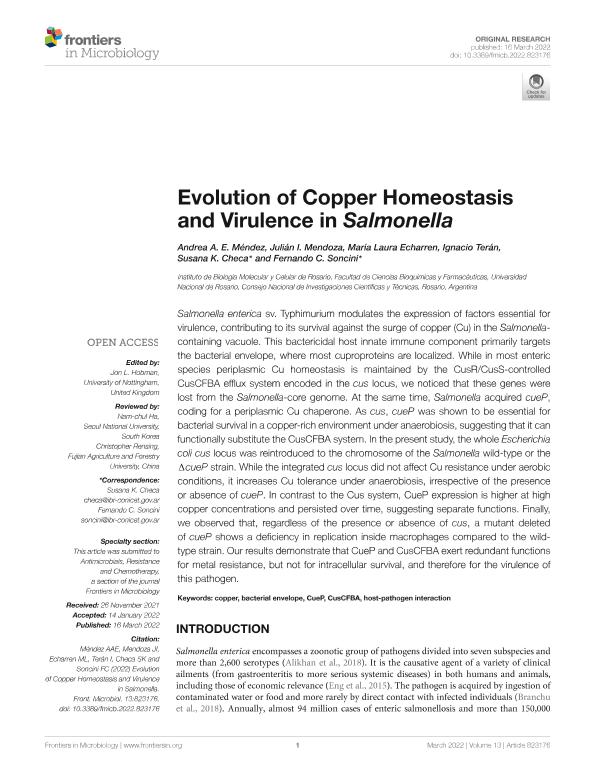Mostrar el registro sencillo del ítem
dc.contributor.author
Mendez, Andrea Analia Elena

dc.contributor.author
Mendoza Fernández, Julián Ignacio

dc.contributor.author
Echarren, María Laura

dc.contributor.author
Terán, Ignacio
dc.contributor.author
Checa, Susana Karina

dc.contributor.author
Soncini, Fernando Carlos

dc.date.available
2023-09-14T14:50:56Z
dc.date.issued
2022-03
dc.identifier.citation
Mendez, Andrea Analia Elena; Mendoza Fernández, Julián Ignacio; Echarren, María Laura; Terán, Ignacio; Checa, Susana Karina; et al.; Evolution of Copper Homeostasis and Virulence in Salmonella; Frontiers Media; Frontiers in Microbiology; 13; 3-2022; 1-11
dc.identifier.uri
http://hdl.handle.net/11336/211529
dc.description.abstract
Salmonella enterica sv. Typhimurium modulates the expression of factors essential for virulence, contributing to its survival against the surge of copper (Cu) in the Salmonella-containing vacuole. This bactericidal host innate immune component primarily targets the bacterial envelope, where most cuproproteins are localized. While in most enteric species periplasmic Cu homeostasis is maintained by the CusR/CusS-controlled CusCFBA efflux system encoded in the cus locus, we noticed that these genes were lost from the Salmonella-core genome. At the same time, Salmonella acquired cueP, coding for a periplasmic Cu chaperone. As cus, cueP was shown to be essential for bacterial survival in a copper-rich environment under anaerobiosis, suggesting that it can functionally substitute the CusCFBA system. In the present study, the whole Escherichia coli cus locus was reintroduced to the chromosome of the Salmonella wild-type or the ΔcueP strain. While the integrated cus locus did not affect Cu resistance under aerobic conditions, it increases Cu tolerance under anaerobiosis, irrespective of the presence or absence of cueP. In contrast to the Cus system, CueP expression is higher at high copper concentrations and persisted over time, suggesting separate functions. Finally, we observed that, regardless of the presence or absence of cus, a mutant deleted of cueP shows a deficiency in replication inside macrophages compared to the wild-type strain. Our results demonstrate that CueP and CusCFBA exert redundant functions for metal resistance, but not for intracellular survival, and therefore for the virulence of this pathogen.
dc.format
application/pdf
dc.language.iso
eng
dc.publisher
Frontiers Media

dc.rights
info:eu-repo/semantics/openAccess
dc.rights.uri
https://creativecommons.org/licenses/by/2.5/ar/
dc.subject
BACTERIAL ENVELOPE
dc.subject
COPPER
dc.subject
CUEP
dc.subject
CUSCFBA
dc.subject
HOST-PATHOGEN INTERACTION
dc.subject.classification
Biología Celular, Microbiología

dc.subject.classification
Ciencias Biológicas

dc.subject.classification
CIENCIAS NATURALES Y EXACTAS

dc.title
Evolution of Copper Homeostasis and Virulence in Salmonella
dc.type
info:eu-repo/semantics/article
dc.type
info:ar-repo/semantics/artículo
dc.type
info:eu-repo/semantics/publishedVersion
dc.date.updated
2023-07-07T20:17:17Z
dc.identifier.eissn
1664-302X
dc.journal.volume
13
dc.journal.pagination
1-11
dc.journal.pais
Suiza

dc.journal.ciudad
Lausana
dc.description.fil
Fil: Mendez, Andrea Analia Elena. Consejo Nacional de Investigaciones Científicas y Técnicas. Centro Científico Tecnológico Conicet - Rosario. Instituto de Biología Molecular y Celular de Rosario. Universidad Nacional de Rosario. Facultad de Ciencias Bioquímicas y Farmacéuticas. Instituto de Biología Molecular y Celular de Rosario; Argentina
dc.description.fil
Fil: Mendoza Fernández, Julián Ignacio. Consejo Nacional de Investigaciones Científicas y Técnicas. Centro Científico Tecnológico Conicet - Rosario. Instituto de Biología Molecular y Celular de Rosario. Universidad Nacional de Rosario. Facultad de Ciencias Bioquímicas y Farmacéuticas. Instituto de Biología Molecular y Celular de Rosario; Argentina
dc.description.fil
Fil: Echarren, María Laura. Consejo Nacional de Investigaciones Científicas y Técnicas. Centro Científico Tecnológico Conicet - Rosario. Instituto de Biología Molecular y Celular de Rosario. Universidad Nacional de Rosario. Facultad de Ciencias Bioquímicas y Farmacéuticas. Instituto de Biología Molecular y Celular de Rosario; Argentina
dc.description.fil
Fil: Terán, Ignacio. Consejo Nacional de Investigaciones Científicas y Técnicas. Centro Científico Tecnológico Conicet - Rosario. Instituto de Biología Molecular y Celular de Rosario. Universidad Nacional de Rosario. Facultad de Ciencias Bioquímicas y Farmacéuticas. Instituto de Biología Molecular y Celular de Rosario; Argentina
dc.description.fil
Fil: Checa, Susana Karina. Consejo Nacional de Investigaciones Científicas y Técnicas. Centro Científico Tecnológico Conicet - Rosario. Instituto de Biología Molecular y Celular de Rosario. Universidad Nacional de Rosario. Facultad de Ciencias Bioquímicas y Farmacéuticas. Instituto de Biología Molecular y Celular de Rosario; Argentina
dc.description.fil
Fil: Soncini, Fernando Carlos. Consejo Nacional de Investigaciones Científicas y Técnicas. Centro Científico Tecnológico Conicet - Rosario. Instituto de Biología Molecular y Celular de Rosario. Universidad Nacional de Rosario. Facultad de Ciencias Bioquímicas y Farmacéuticas. Instituto de Biología Molecular y Celular de Rosario; Argentina
dc.journal.title
Frontiers in Microbiology
dc.relation.alternativeid
info:eu-repo/semantics/altIdentifier/url/https://www.frontiersin.org/articles/10.3389/fmicb.2022.823176/full
dc.relation.alternativeid
info:eu-repo/semantics/altIdentifier/doi/http://dx.doi.org/10.3389/fmicb.2022.823176
Archivos asociados
